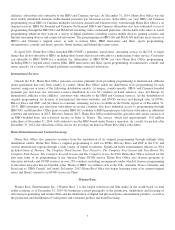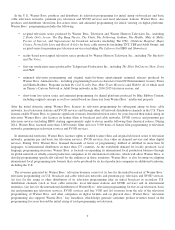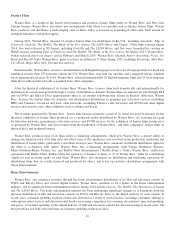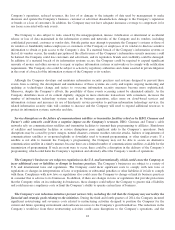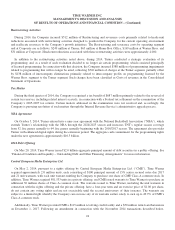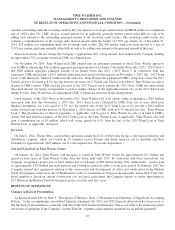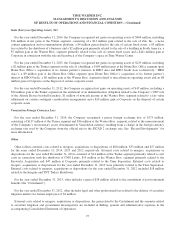Time Magazine 2014 Annual Report Download - page 33
Download and view the complete annual report
Please find page 33 of the 2014 Time Magazine annual report below. You can navigate through the pages in the report by either clicking on the pages listed below, or by using the keyword search tool below to find specific information within the annual report.The Company’s operating results may suffer if it cannot continue to license and exploit its intellectual property
rights. The Company relies on a combination of patents, copyrights, trademarks, tradenames and other proprietary rights, as
well as contractual arrangements, including licenses, to establish, maintain and protect its intellectual property rights.
Effective intellectual property protection may not be available in every country in which the Company does business. The
Company may not be able to acquire or maintain appropriate domain names in all countries in which it does business or
prevent others from acquiring domain names that are similar to, infringe on, or diminish the value of, the Company’s
trademarks and other proprietary rights. Companies that license the Company’s intellectual property also may take actions
that diminish the value of the Company’s intellectual property or harm the Company’s reputation.
The Company’s intellectual property rights may not be sufficient to permit it to take advantage of business opportunities,
such as new distribution platforms. As a result, the Company may be required to change its plans or acquire the necessary
intellectual property rights, which could be costly.
The protection of the Company’s intellectual property may require the Company to spend significant amounts of money.
Further, the steps the Company takes to protect its intellectual property may not adequately protect its rights or prevent others
from infringing or misappropriating its intellectual proprietary rights. Any impairment of the Company’s intellectual
property rights, including due to changes in U.S. or foreign intellectual property laws or the absence of effective legal
protections or enforcement measures, could adversely impact the Company’s businesses, financial condition and results of
operations.
The Company has been, and may be in the future, subject to claims that it infringed intellectual property rights of
others, which could require the Company to change its business practices. Successful claims that the Company infringes on
the intellectual property rights of others could require the Company to enter into royalty or licensing agreements on
unfavorable terms, incur substantial monetary liability, be prohibited preliminarily or permanently from further use of the
intellectual property in question or require the Company to change its business practices to stop the infringing use, which
could limit its ability to compete effectively. Even if the Company believes a claim of intellectual property infringement is
without merit, defending against the claim can be time-consuming and costly and divert management’s attention and
resources away from its businesses.
The Company’s businesses are subject to labor interruption. The Company and some of its suppliers and business
partners retain the services of writers, directors, actors, athletes, technicians, trade employees and others involved in the
development and production of its television programming and feature films who are covered by collective bargaining
agreements. If negotiations to renew expiring collective bargaining agreements are not successful or become unproductive,
the affected unions could take actions such as strikes, work slowdowns or work stoppages. Strikes, work slowdowns or work
stoppages or the possibility of such actions could result in delays in the production of the Company’s television programming
and feature films. The Company could also incur higher costs from such actions, new collective bargaining agreements or the
renewal of collective bargaining agreements on less favorable terms. Many of the collective bargaining agreements that cover
individuals providing services to the Company are industry-wide agreements, and the Company may lack practical control
over the negotiations and terms of these agreements. Union or labor disputes or player lock-outs relating to certain
professional sports leagues may preclude the Company from producing and telecasting scheduled games or events and could
negatively impact the Company’s promotional and marketing opportunities. Depending on their duration, such union or labor
disputes or player lock-outs could have an adverse effect on the Company’s results of operations.
Service disruptions or failures of the Company’s or its vendors’ information systems and networks as a result of
computer viruses, misappropriation of data or other bad acts, natural disasters, extreme weather, accidental releases of
information or other similar events, may disrupt the Company’s businesses, damage its reputation or have a negative
impact on its results of operations. Shutdowns or service disruptions of information systems or networks at the Company or
vendors that provide information systems, networks or other services to the Company pose increasing risks. Such disruptions
may be caused by third-party hacking of computers and systems; dissemination of computer viruses, worms and other
destructive or disruptive software; denial of service attacks and other bad acts, as well as power outages, natural disasters,
extreme weather, terrorist attacks, or other similar events. Shutdowns or disruption from such events could have an adverse
impact on the Company and its customers, including degradation or disruption of service, loss of data and damage to
equipment and data. In addition, system redundancy may be ineffective or inadequate, and the Company’s disaster recovery
planning may not be sufficient to cover everything that could happen. Significant events could result in a disruption of the
17


